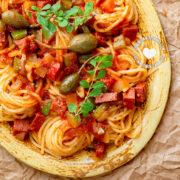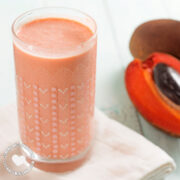Salami frito is quintessentially Dominican. Almost all of us Dominicans love our fried salami, and it's part of our favorite breakfast. But have you ever wondered where it came from, and if you can make Dominican salami at home?
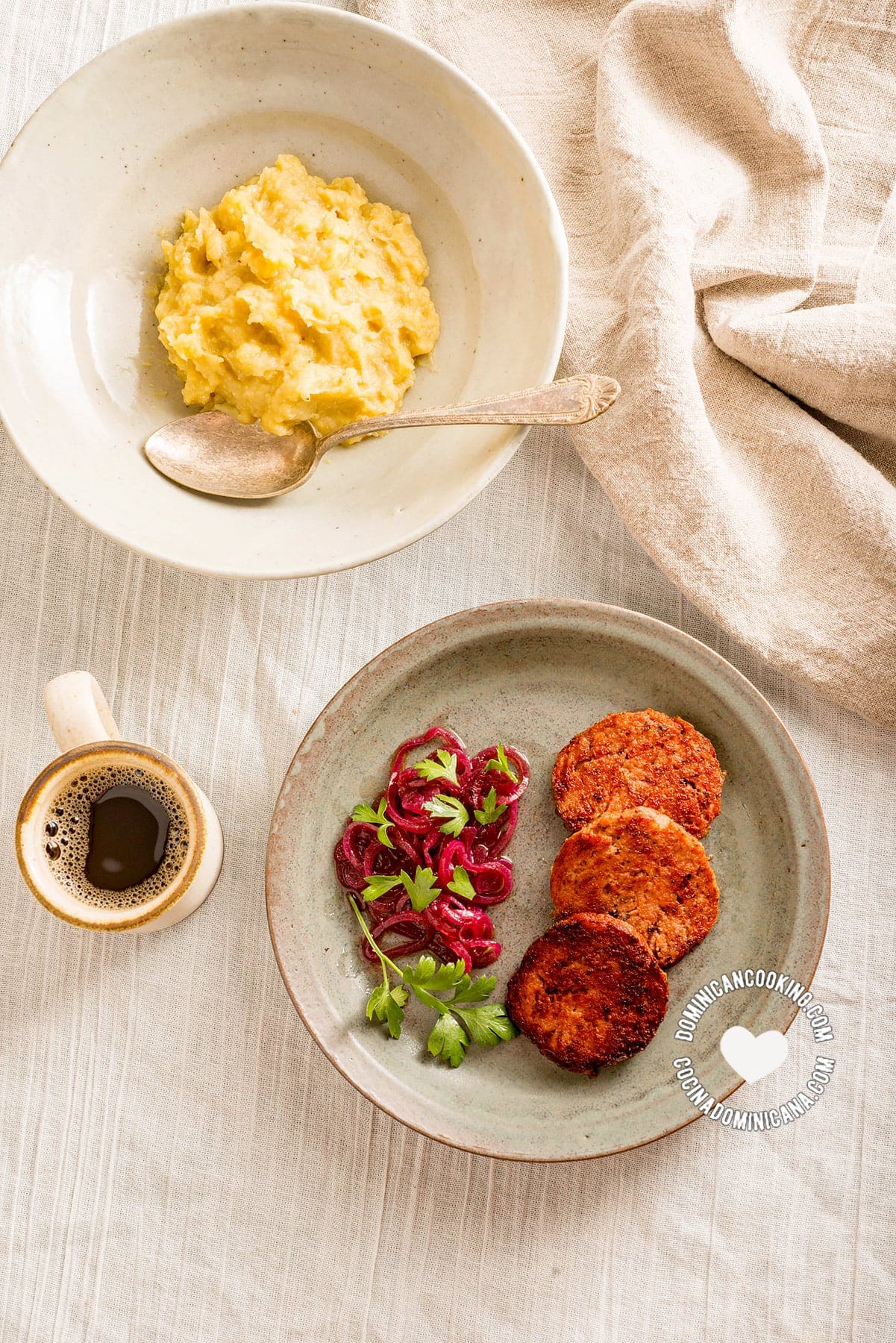
Why we ❤️ it
Dominican salami is very popular among our people, and we serve it for breakfast, lunch, or dinner. In this recipe, we present you with how to make the traditional fried Dominica salami that we love so much and a vital part of our star breakfast: mangú con los tres golpes.
But what if where you live it is impossible to buy Dominican salami and nostalgia punches you in the stomach, and you crave those little pleasures of your homeland? That's the reality for a large percentage of our readers, and I have a tasty solution for you. Well, I have here the best idea for that.
What's salami dominicano?
Salchichon Dominicano, or Dominican salami is a type of meat product made from beef and pork, a large pre-cooked sausage that Dominicans traditionally serve as part of our traditional breakfast.
It is also called salchichón, but only borrows its name from these Italian and Spanish products respectively.
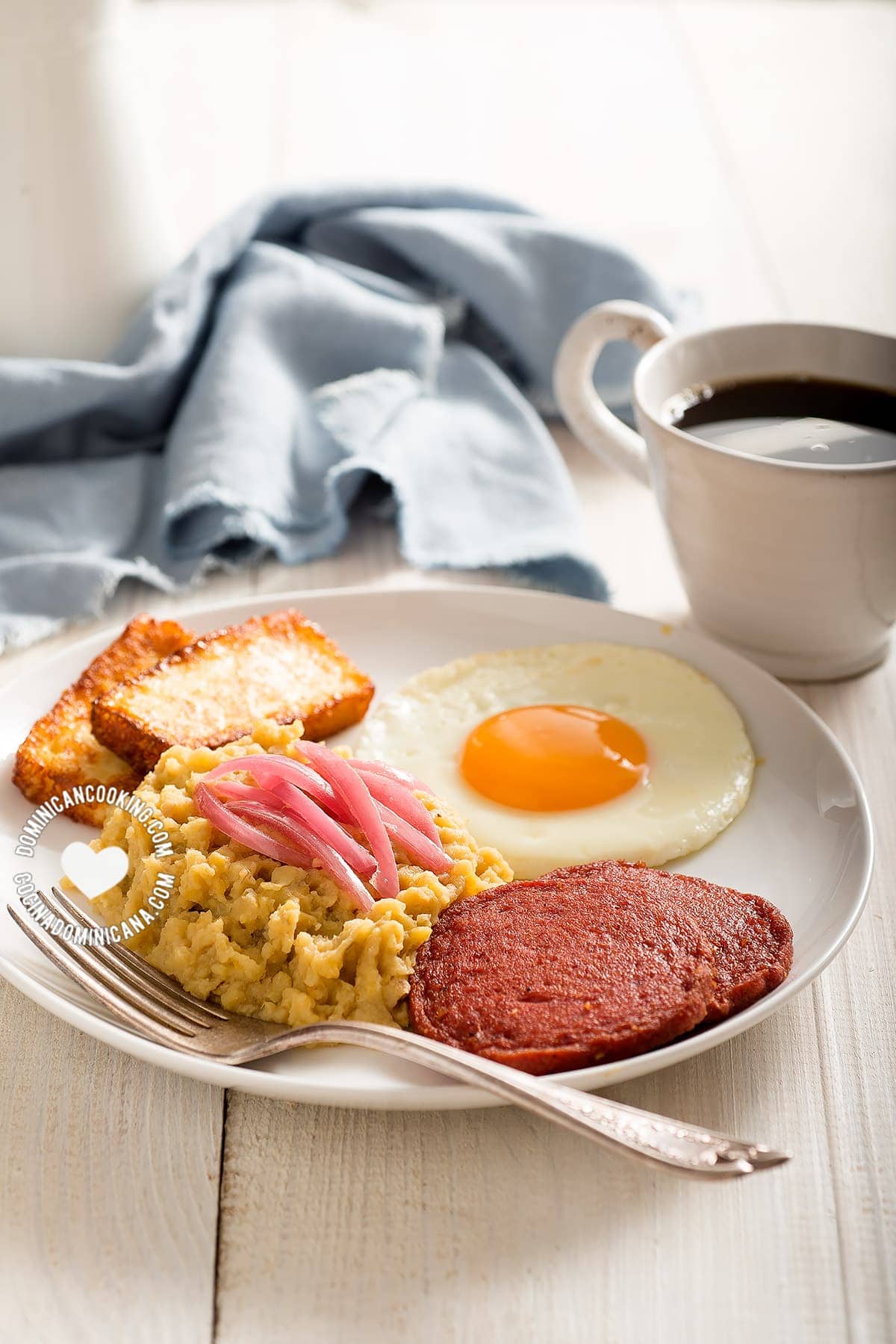
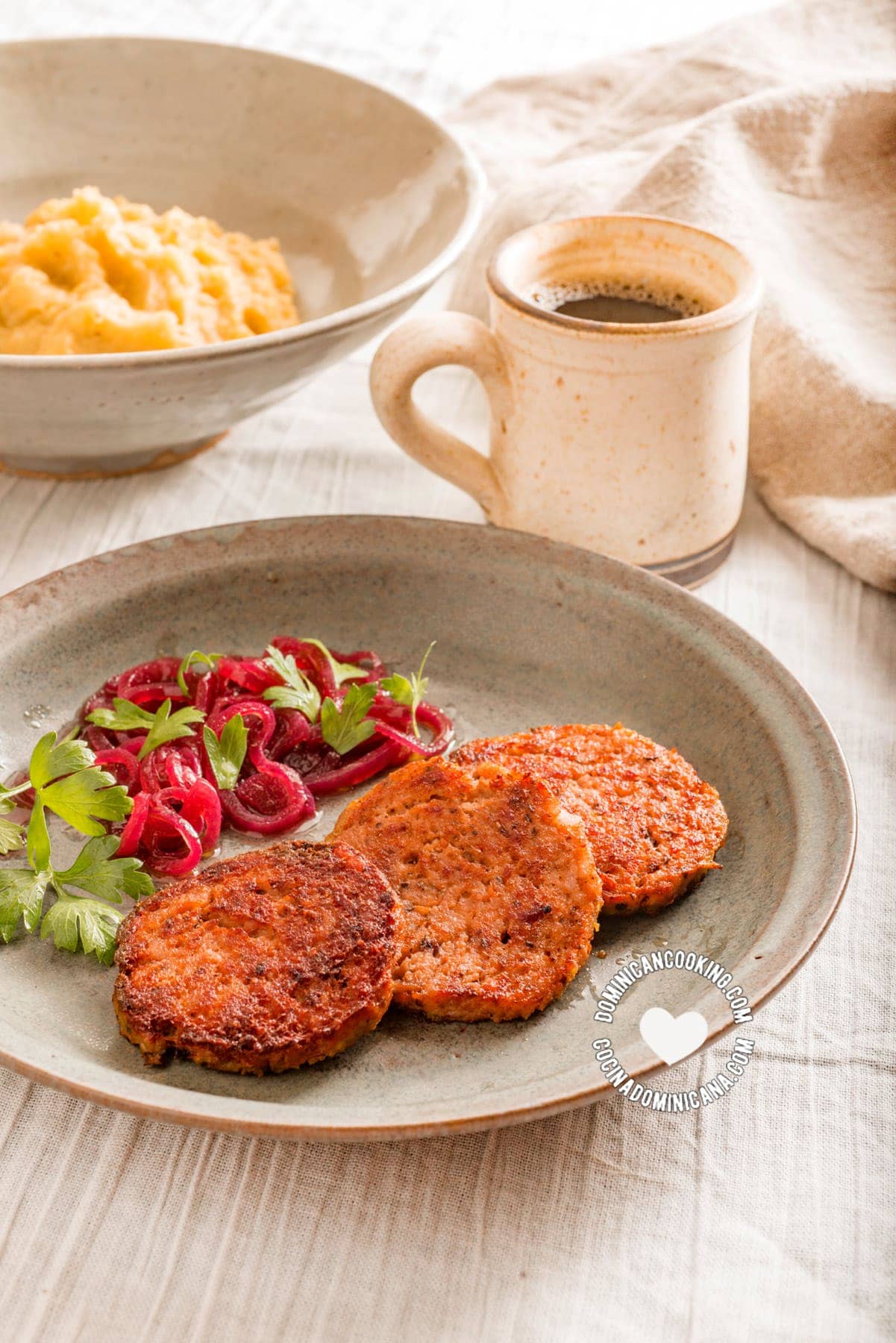
History and culture
Although Dominican salami shares its name with Italian salami and Spanish salchichón, the history of Dominican salami is very interesting and extends to one of the darkest periods of modern history.
Dominican salami recipes
Other than this recipe for fried salami, these are the most popular ways we serve salami.
Serving suggestions
You can serve fried salami with mangú and Dominican sauteed onions. You can also serve it with yuca encebollada, puré de auyama, or mashed yautía. Avocado slices are always welcome.
Another very popular way to serve it is combining Salami frito and tostones
Top tips
Make sure you cook it over very low heat, just enough to see bubbles rising from the bottom of the pot. You do not want the plastic to melt, it may be food-safe, but not edible.
A few things to keep in mind: The salami is not as perfectly round as the store-bought kind, but I got my logs pretty round and even. It is also not as compact as the industrial kind. I had to be a bit careful when cutting and manipulating.
There are no preservatives in this (other than salt and seasonings), so observe the same storage guidelines as any other cooked meat. You can also cut it into slices and divide into serving sizes and freeze it for later use.
About our recipe
The fried salami recipe is super easy and not complicated at all. We leave it below. But as we mentioned at the beginning, we also wanted to offer a solution for those who can't buy salami where they live, which is a significant percentage of our readers abroad. We hope you enjoy it.
Read more about my homemade salami
Yeah, I know, it's crazy. Why am I even doing this? You can just walk into a colmado and buy salami. It makes no sense.
This is not the first time I've tackled a recipe that seems to make little sense to us here on the island. Who needs to make casabe at home? Or gofio? Or longaniza? Or, heaven forfend, salami?! Why would anyone want to know how to make Dominican salami?
I'll tell you who...
If you live in la tierrita, or any of those places with a gazillion Dominicans, this is probably not for you -- though I suggest you keep reading -- but you'll be surprised how many times people have asked us to come up with a recipe for homemade salami and those other staples that many can just walk into a colmado -- or bodega -- and buy. Not everybody has those at hand.
So what do you do when one day you wake up, and nostalgia just punches you in the stomach, and you crave some of the simple pleasures of the homeland? Have you been there? This is a reality for many of our readers. And we get it, which explains why I spent a whole month testing this recipe, taking notes, pictures, and redoing it over and over. I got the flavor right the first time, but the texture didn't work for me so I spent many hours and a lot of food trying new ideas.
Let me make something clear: this Homemade Dominican Salami isn't anywhere as cheap as the real thing. And while it may not have any preservatives, and we can be sure what went into it, it is by no means a healthy choice. That much should be obvious. What it is is very tasty. The flavors are very, very close to the real thing, and the texture is reasonably close.
There was another reason: Let's face it, salami (also known as salchichón) has a very spotty reputation. Not a year goes by when it doesn't hit the news, and not for the right reasons. In 14 years I've only bought it a few times, every time to develop recipes for our blog.
But I know I am privileged in that I can choose not to eat it -- though I admit it is pretty darn tasty. For many a Dominican, this is not a matter of taste, it's just a very inexpensive source of protein, a quick solution to the morning breakfast, or the day's dinner. Yet even those who buy salami because they can barely afford anything else will joke about it. You know what I am talking about.
Make it because you are curious. Make it because you miss the store-bought kind but can't find it. Make it because you'd prefer to know what's in your food. Make it because it is actually fun to do this. Just please don't complain that it isn't exactly like the one you bought at the colmado. Cause it isn't. And I am fine with that.

Recipe
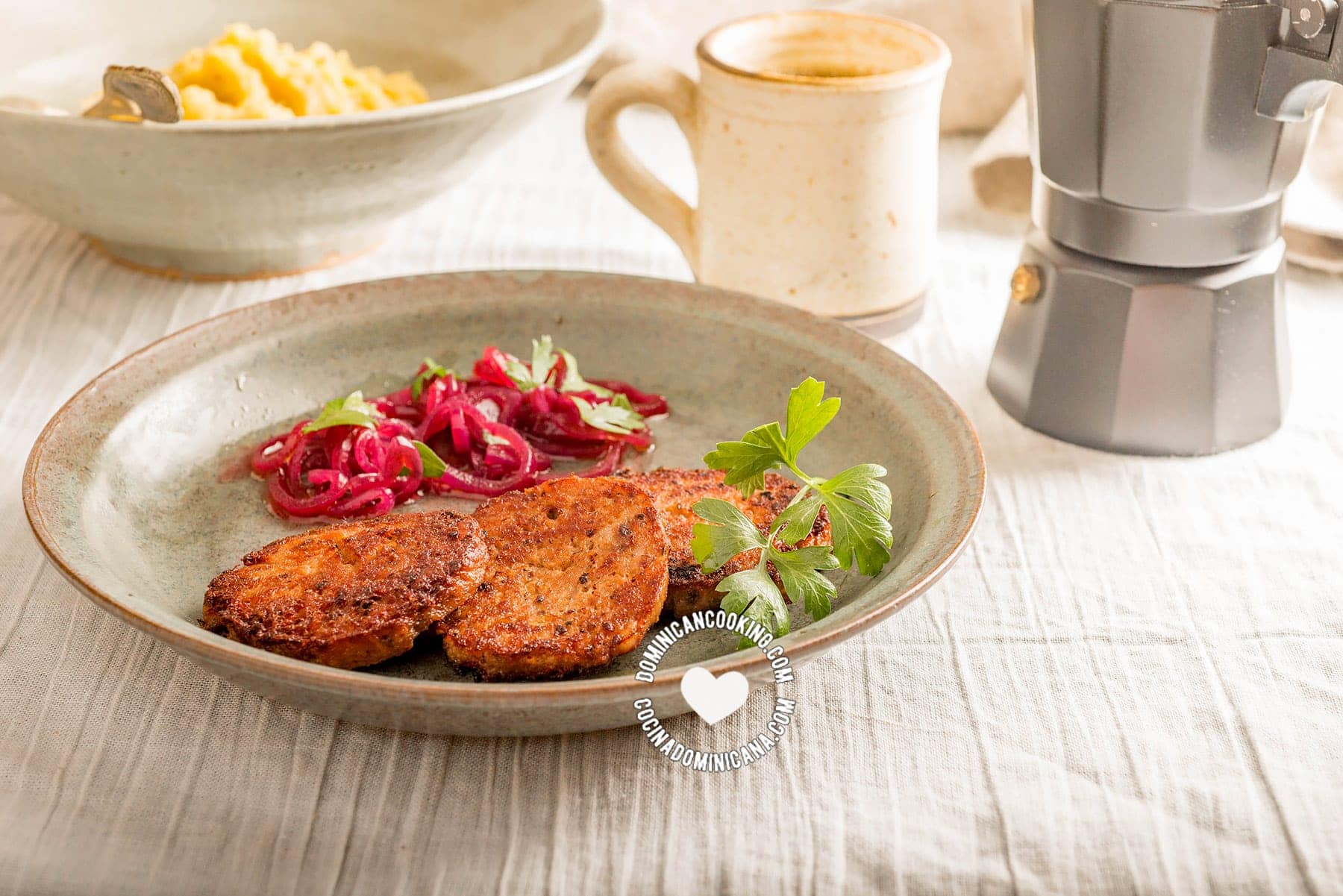
[Recipe + Video] Salami Dominican Frito (Fried) & Homemade Dominican Salami
Ingredients
Dominican fried salami
- 1 pound Dominican salami, (or homemade with recipe below) (or homemade with recipe below)
- 1 cup oil for frying
Homemade Dominican salami
- 1 medium red onion
- 3 cloves garlic
- 1 tablespoon oregano (dry, ground)
- 1 tablespoon pepper (freshly-cracked, or ground)
- 1 teaspoon salt
- 2½ tablespoon bija (annato, achiote) powder, use sweet paprika if it's impossible to find bija. We use it as coloring to give red color to the salami.
- ¼ cup all-purpose flour
- ½ pound minced beef, [0.22 kg]
- 4 egg white
- ½ pound bacon, [0.22 kg]
Instructions
Salami frito
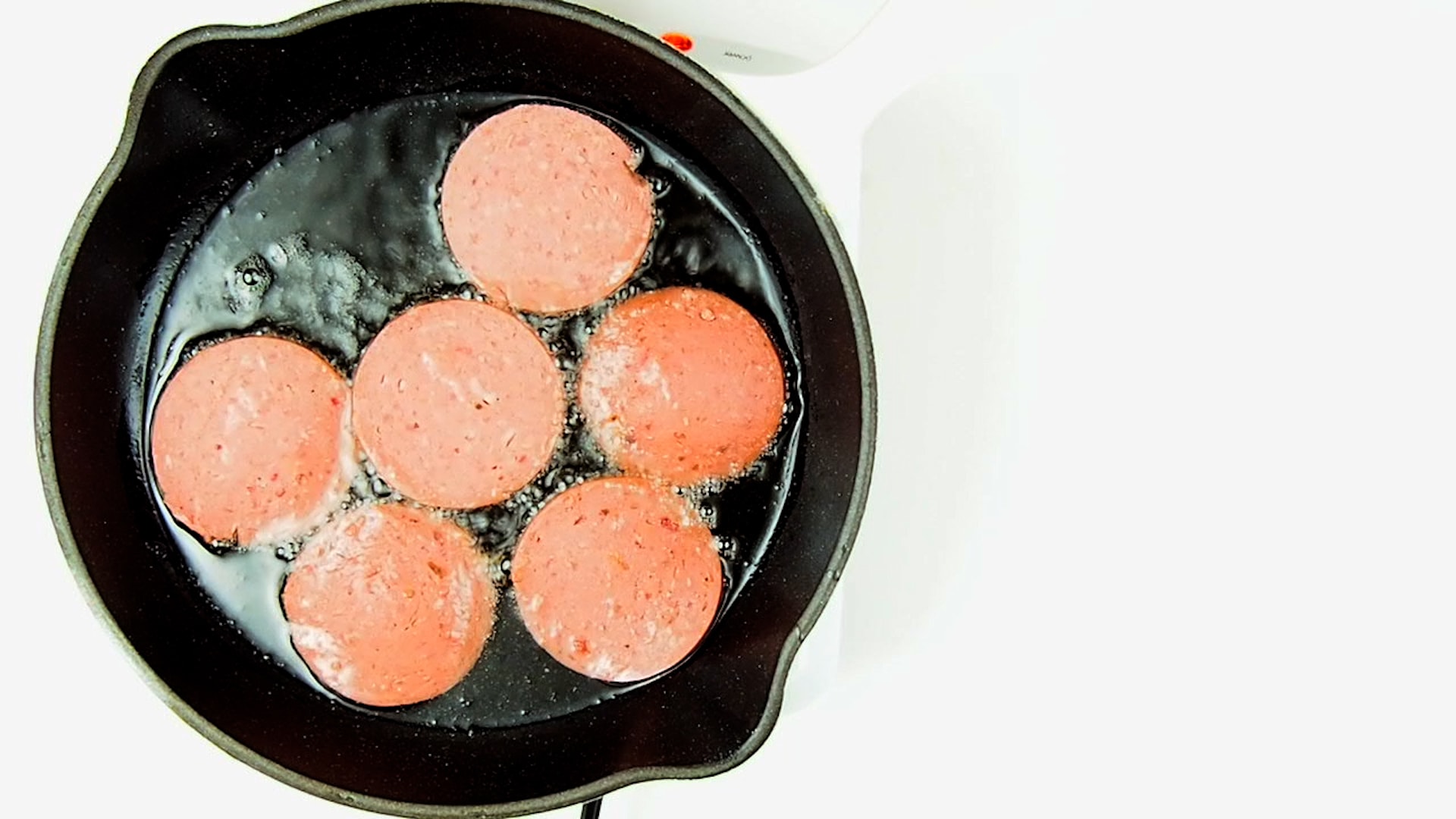 Heat the oil in a skillet over medium-high heat. Fry the salami slices on both sides until lightly browned and the edges are darker.Let them rest on a paper towel to absorb excess oil, and serve according to the suggestions above the recipe.
Heat the oil in a skillet over medium-high heat. Fry the salami slices on both sides until lightly browned and the edges are darker.Let them rest on a paper towel to absorb excess oil, and serve according to the suggestions above the recipe.
Homemade Dominicn salami
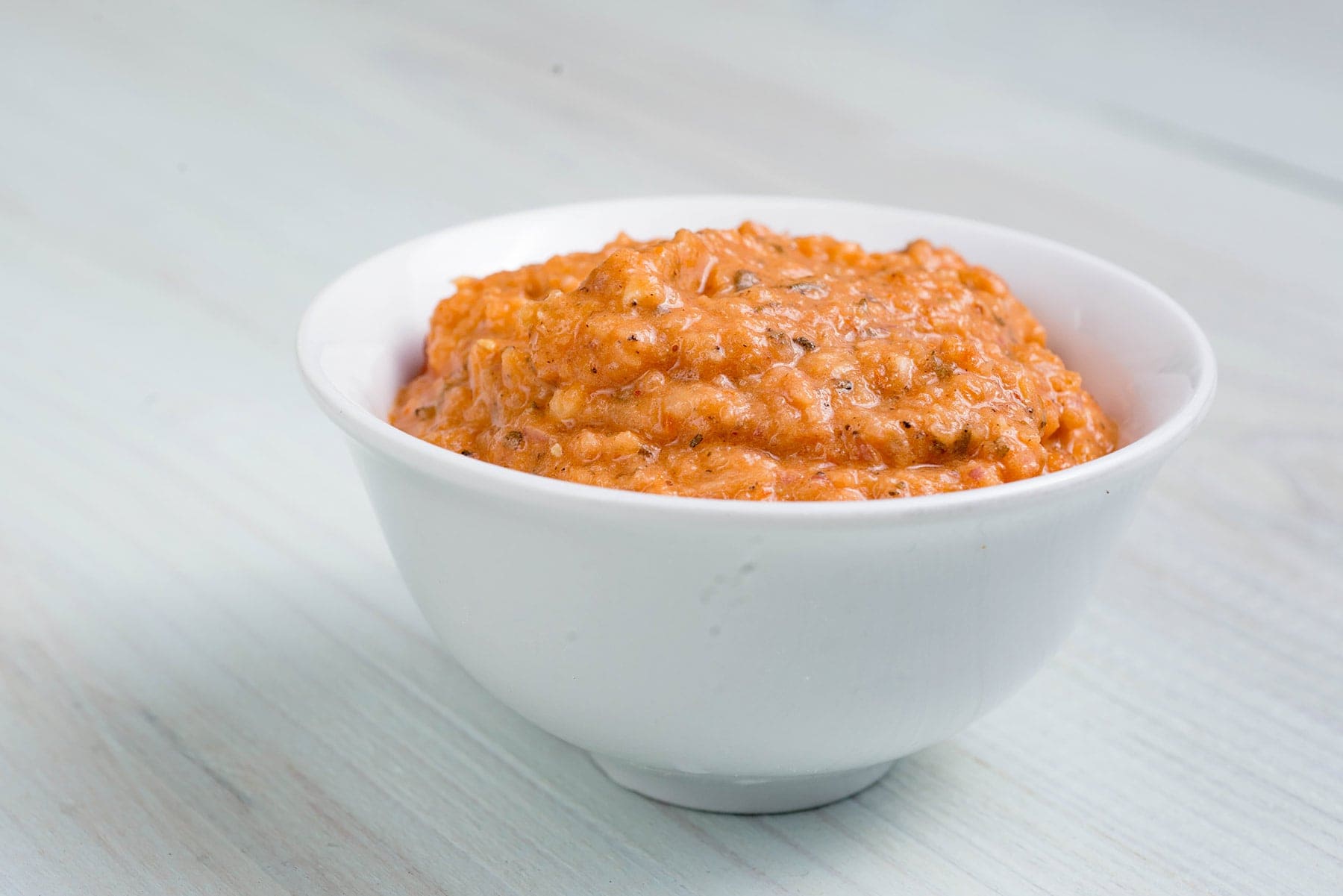 Place onion, garlic, oregano, pepper, salt, bija, and flour in the food processor. Pulse until you obtain a coarse paste. Set aside.
Place onion, garlic, oregano, pepper, salt, bija, and flour in the food processor. Pulse until you obtain a coarse paste. Set aside.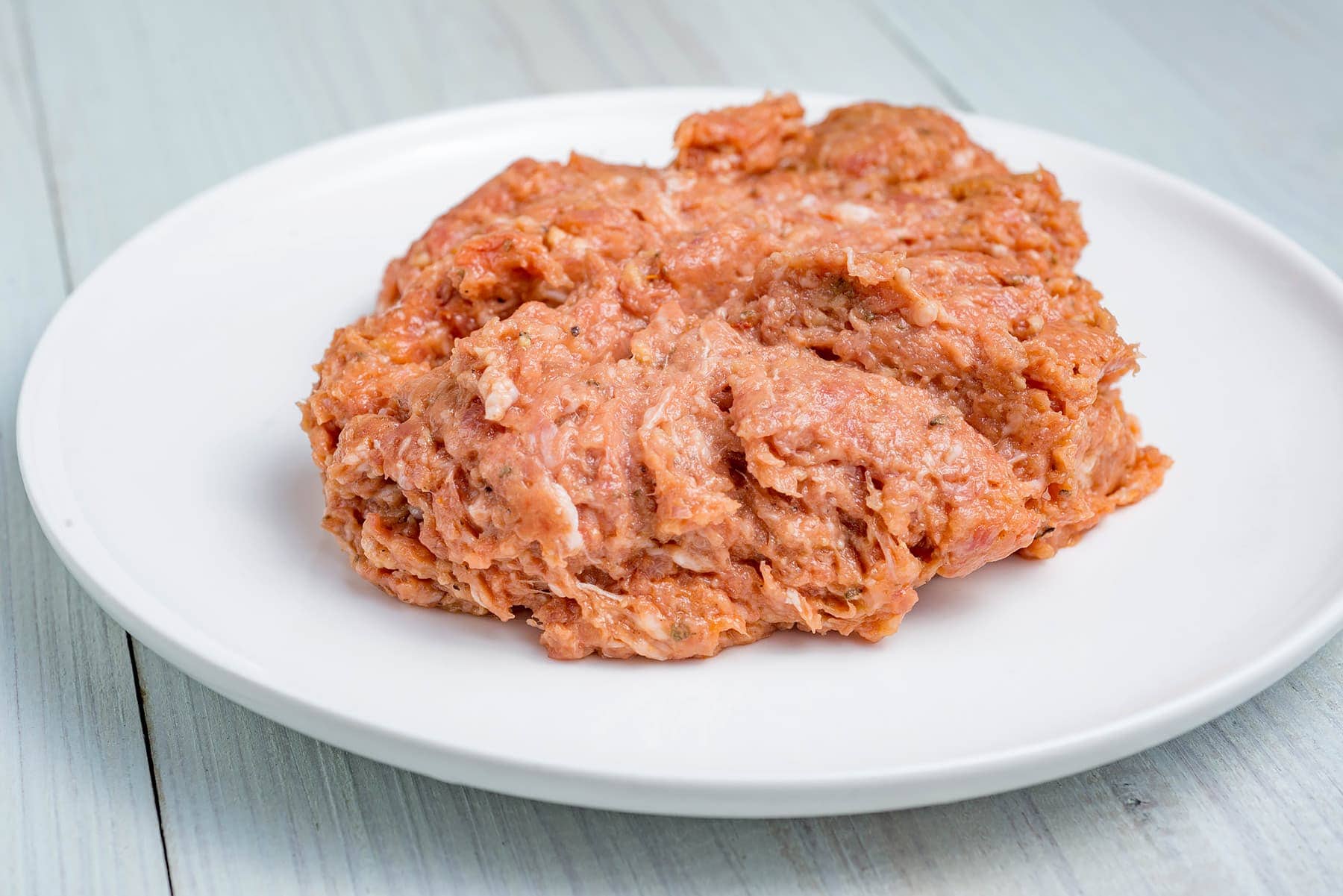 Place the minced beef in the food processor and pulse for two minutes, by then the meat would have turned into a smooth paste. Add in egg whites, bacon, and the seasoning paste. Pulse until the bacon is chopped finely. Remove from the processor and place in a bowl. Cover with plastic film and chill for two hours.
Place the minced beef in the food processor and pulse for two minutes, by then the meat would have turned into a smooth paste. Add in egg whites, bacon, and the seasoning paste. Pulse until the bacon is chopped finely. Remove from the processor and place in a bowl. Cover with plastic film and chill for two hours.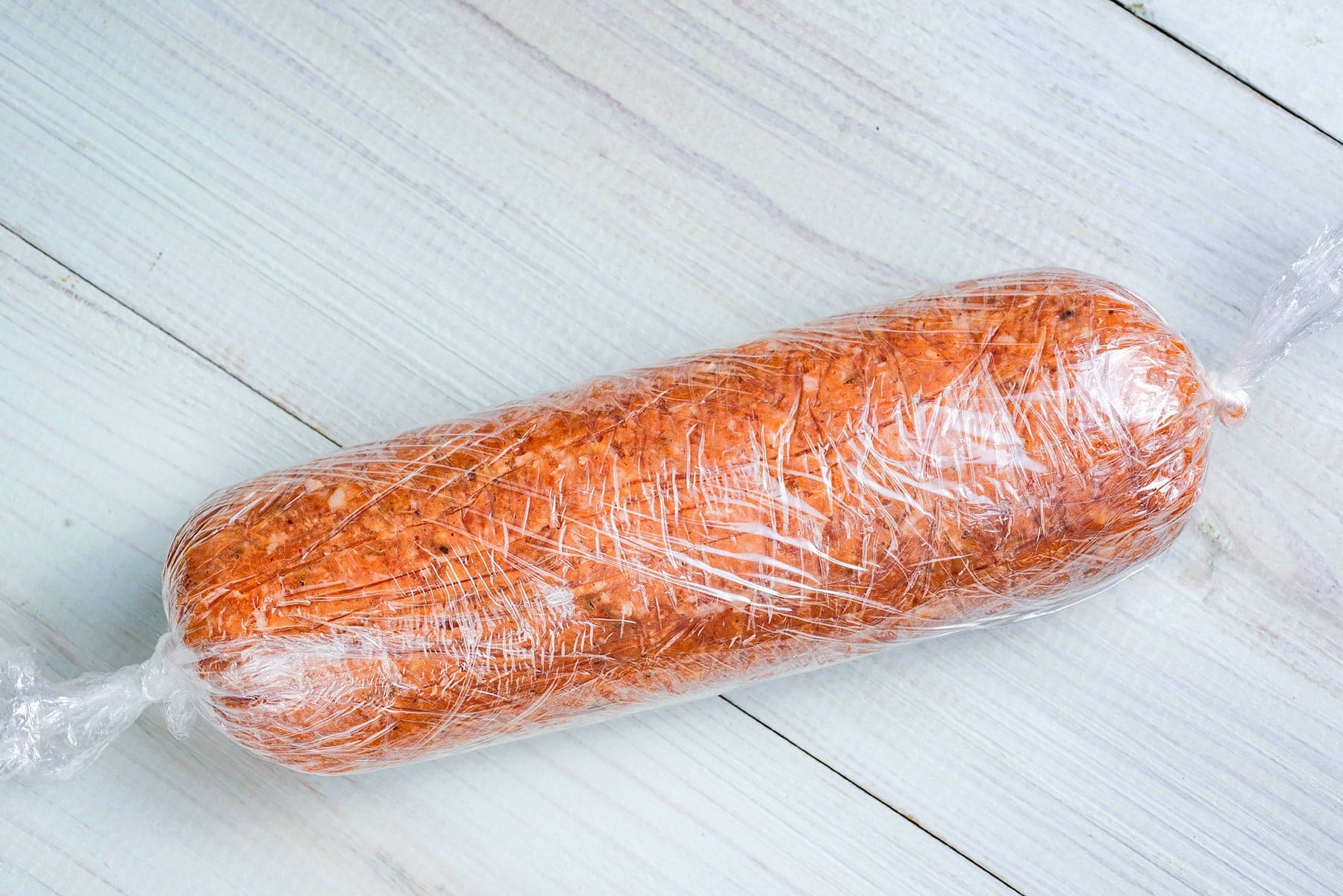 Roll out a very large piece of heat-safe plastic wrap (about 1 yard [1 meter]), and lay it flat on the countertop. Place the meat mixture on it and form a log. Wrap in the film, rolling until the end, leaving at least two inches at the ends.Place the meat mixture on it and form a log. Wrap in the film, rolling until the end, leaving at least two inches at the ends. Tie the ends with a knot (or using an oven-safe tie-wrap). Return to the fridge.
Roll out a very large piece of heat-safe plastic wrap (about 1 yard [1 meter]), and lay it flat on the countertop. Place the meat mixture on it and form a log. Wrap in the film, rolling until the end, leaving at least two inches at the ends.Place the meat mixture on it and form a log. Wrap in the film, rolling until the end, leaving at least two inches at the ends. Tie the ends with a knot (or using an oven-safe tie-wrap). Return to the fridge.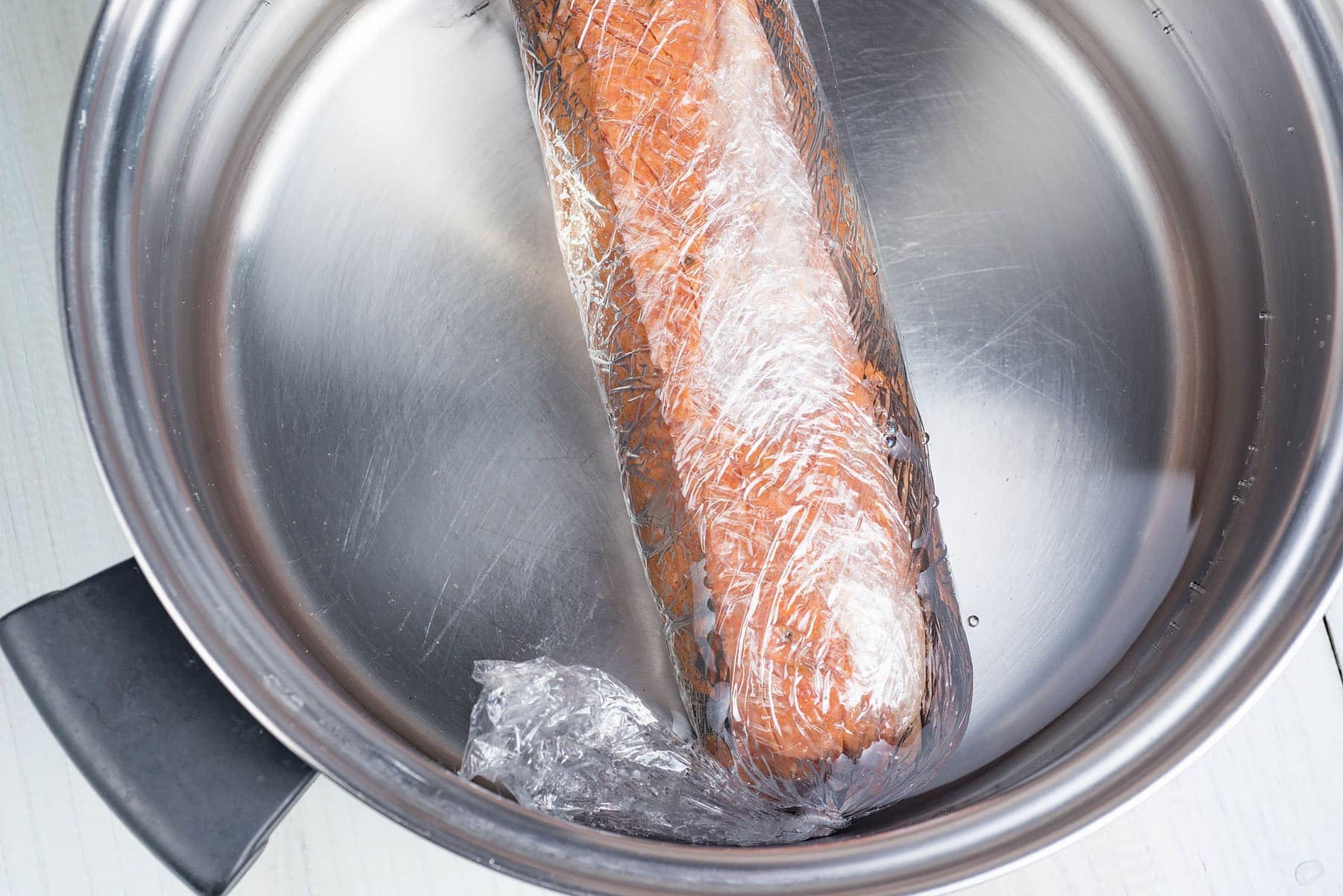 In the meantime, fill a large pot with 1 gallon [4 lt] of water. Heat over medium-low heat until it reaches a gentle boil (there are bubbles rising from the bottom of the pot). Lower heat to a minimum (see notes).Place the meat log into a watertight, oven-safe plastic zipper bag, and squeeze all the air out before zipping closed. Place in the pot with the boiling water. Cover and cook for 60 minutes.
In the meantime, fill a large pot with 1 gallon [4 lt] of water. Heat over medium-low heat until it reaches a gentle boil (there are bubbles rising from the bottom of the pot). Lower heat to a minimum (see notes).Place the meat log into a watertight, oven-safe plastic zipper bag, and squeeze all the air out before zipping closed. Place in the pot with the boiling water. Cover and cook for 60 minutes.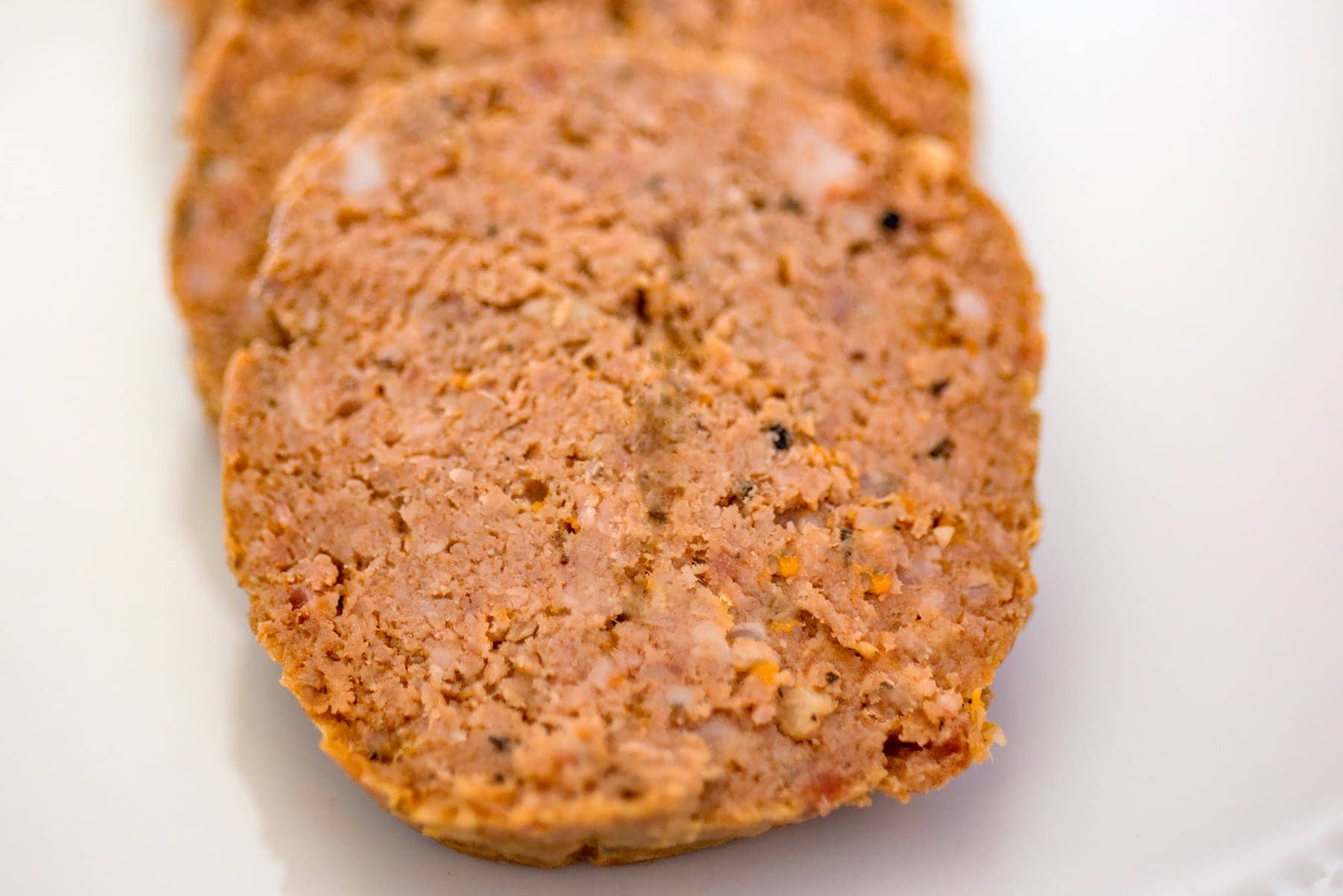 Remove the salami from the pot and cool to room temperature. Chill.If you are going to slice, do it right out of the refrigerator because it is easier. To fry follow the instructions in the first step of the recipe.
Remove the salami from the pot and cool to room temperature. Chill.If you are going to slice, do it right out of the refrigerator because it is easier. To fry follow the instructions in the first step of the recipe.
Video
Tips and Notes
Nutrition
Nutritional information is calculated automatically based on ingredients listed. Please consult your doctor if you need precise nutritional information.
History of Dominican salami
This part was researched and written by Aunt Ilana
After my arrival in the Dominican Republic close to a quarter of a century ago, I heard the fascinating story of the Jewish community of Sosúa and visited the museum there. Sosúa is a seaside town on the north coast of the Dominican Republic, a short drive eastwards from the provincial capital, Puerto Plata. In recent decades Sosúa’s scenic bay and the lovely yellow sand beach have made it a popular destination for tourists and expatriates. In the late 1930s, however, Sosúa was a remote backwater, described as “an abandoned banana plantation.”Half a world away, on the eve of World War II, the Jews of Europe were becoming increasingly desperate to flee the horrors that lay in store for them in the face of Nazi persecution. Many did everything they could to escape from Germany and Austria, but not many nations were willing to grant them entry.
One of the few countries that opened its doors was one they had probably never heard of. In 1938, the then-dictator of the Dominican Republic, Rafael Trujillo agreed to accept 100,000 Jews, although, in the end, fewer than one thousand people were able to make the long sea voyage and settle in this safe Caribbean haven. When researching the influences of other immigrant communities on the gastronomy of the Dominican Republic, I recalled the story of Sosúa and wondered if any Ashkenazi (European Jewish) culinary traditions brought over by these refugees had made their mark on Dominican cuisine along with Chinese and Middle Eastern-influenced dishes like chofán and tipili, niños envueltos? Maybe, but this dish is much more likely to have arrived with Arab immigrants from the Middle East, who came in much greater numbers and would have known it as malfoof mahshi.
The answer to my question is simpler than that. It doesn’t involve a traditional Ashkenazi Jewish dish, though. The Jewish community of Sosúa can take credit for introducing one simple ingredient that is at the heart of every Dominican breakfast.
Upon arrival in Sosúa, each family was given a plot of land, some livestock, and a loan. The Jewish immigrants soon developed a thriving dairy and meat business. This company, Productos Sosúa, became a household name in the Dominican Republic, and its products with their distinctive red and blue cow logo still grace the shelves of colmados and supermarkets across the country.
Along with staple dairy products like butter and cheese, Productos Sosúa produced processed meats including sausages and salami. Inexpensive and tasty, salami was enthusiastically adopted by Dominicans as the fried centerpiece of the traditional breakfast dish known as Los Tres Golpes – the three strikes.
FAQs
The main ingredients in Dominican salami are pork and beef meat, spices, most notably pepper, and many other ingredients are part of proprietary recipes.
The most popular way to eat Dominican salami is fried, other dishes are salami guisado, locrio de salami and in Dominican spaghetti.
References
- The Ugly Story Behind a Breakfast Meat by Pippa Biddle, BBC Travel, 1 June 2017
- Jewish Virtual Library: Dominican Republic Provides Sosua as a Haven for Jewish Refugees by Lauren Levy
- Washington Post: I thought I knew how my family escaped the Holocaust. The truth was hidden in a Dominican town. By Emily Codik, October 17, 2017
- Dominican Haven: The Jewish Refugee Settlement in Sosua, 1940-1945, Marion Kaplan. Museum of Jewish Heritage (2008)
- Tropical Zion: General Trujillo, FDR, and the Jews of Sosúa, Allen Wells. Duke University Press (2009)
Published Oct 16, 2015, and last revised



